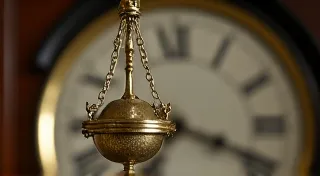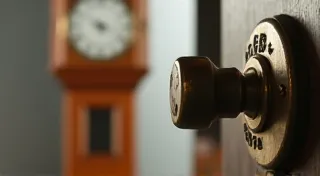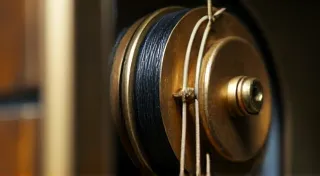Cleaning & Polishing Antique Clock Cases: Preserving the Original Finish
Antique clocks are more than just timekeepers; they’re pieces of history, art, and craftsmanship. The case, often crafted from beautiful woods like oak, mahogany, walnut, or even exotic veneers, plays a crucial role in a clock’s overall appeal and value. Proper cleaning and polishing aren't just about aesthetics; they're about preservation. Incorrect methods can damage the original finish, reducing the clock's worth and potentially requiring costly repairs. This guide provides detailed techniques for cleaning and polishing antique clock cases, ensuring you preserve their beauty for generations to come. The environment plays a vital role too; maintaining proper humidity levels can significantly impact a clock’s condition, and it's something worth considering in conjunction with cleaning. For more on that, you might find “The Importance of Humidity Control for Antique Clocks” a useful read.
Understanding Your Clock Case Finish
Before you even think about cleaning, it's vital to identify the type of finish on your clock case. Common finishes include:
- French Polish: A glossy, mirror-like finish often found on higher-end clocks. Very delicate.
- Shellac: A traditional finish that provides a warm, amber tone. Sensitive to water and alcohol.
- Varnish: A more durable finish, often applied in multiple layers.
- Lacquer: Another durable finish, often used on more modern antique clocks.
- Waxed Finish: A simple finish that offers a soft sheen.
If you're unsure about the finish type, start with the gentlest cleaning methods and test in an inconspicuous area first. If possible, consult a professional clock restorer for identification and advice. Sometimes, issues extend beyond just the case finish; the delicate dial face itself can be a source of concern. Learning to Identifying and Matching Antique Clock Dial Faces can prove invaluable.

Gathering Your Supplies
Having the right tools and materials is essential for a successful cleaning. Here’s a list of what you're likely to need:
- Soft Cloths: Microfiber cloths are ideal; use several so you always have a clean one.
- Gentle Soap: Mild dish soap (like Dawn) diluted in warm water.
- Mineral Spirits: For removing old wax and grime (use with caution and ventilation).
- Furniture Polish: Specifically designed for antique furniture – avoid silicone-based products.
- Wax (Optional): High-quality beeswax or carnauba wax for added protection (after polishing).
- Cotton Swabs: For detailed cleaning in crevices.
- Soft Brushes: For removing dust and debris.
Cleaning the Clock Case: Step-by-Step
- Dusting: Begin by gently dusting the entire clock case with a soft brush or cloth. Pay attention to carvings and intricate details.
- Surface Cleaning: Dip a soft cloth into the diluted soap solution (wring out excess water). Gently wipe the case, following the grain of the wood. Avoid saturating the wood.
- Rinsing (Optional): If you used soap, lightly dampen a clean cloth with plain water and wipe away any soap residue. Dry immediately with a clean, dry cloth.
- Removing Old Wax: If the case has a thick layer of old wax, use mineral spirits to dissolve it. Apply sparingly with a clean cloth, wiping in the direction of the grain. Work in a well-ventilated area. Multiple applications may be needed. Be particularly cautious here; damage can easily occur.
- Drying: Allow the case to dry completely before proceeding to polishing.

Polishing the Clock Case
Polishing restores the luster and vibrancy of the wood. The process varies depending on the finish:
- Shellac/French Polish: Use a specialized shellac polish designed for antiques. Apply sparingly and buff gently with a soft cloth. Avoid excessive rubbing.
- Varnish/Lacquer: Use a furniture polish specifically formulated for varnished or lacquered surfaces. Apply a thin, even coat and buff lightly.
- Waxed Finish: A light buffing with a soft cloth can often revive a waxed finish. If the clock’s mechanisms aren't functioning correctly, consider addressing those issues before focusing solely on the case; a clock is only as good as its overall condition.
Important: Always test any polish in an inconspicuous area first to ensure compatibility.
Beyond the Case: Considering Clock Hands and Weights
While this guide focuses on the clock case, it's important to remember that the entire clock is a system. Damaged or mismatched clock hands can detract significantly from the clock’s overall appearance and value, requiring careful Repairing Broken Clock Hands: From Bending to Soldering Techniques. Similarly, incorrect or missing weights can affect the clock's accuracy and functionality. Understanding and Understanding and Replacing Clock Weights: A Comprehensive Guide is vital for maintaining a working antique clock.
Protecting Your Clock Case
After cleaning and polishing, you can apply a protective layer to help preserve the finish. A thin coat of high-quality wax (beeswax or carnauba) can provide added protection against moisture and grime. Reapply wax periodically, as needed. Proper care isn’t just about surface treatments, though; it extends to the clock’s internal mechanisms as well.
Seeking Professional Help
For valuable or heavily damaged clock cases, or if you’re unsure about any of the steps outlined above, it’s best to consult a professional clock restorer. They have the expertise and tools to handle delicate restorations and ensure the longevity of your antique clock. Their expertise isn’t limited to cases; they can diagnose and repair complex mechanical issues too. The level of detail required for antique clock restoration is often beyond what a homeowner can achieve.

By following these guidelines, you can carefully clean and polish your antique clock case, preserving its beauty and value for generations to come. Remember that antique clocks are not just objects; they are tangible links to the past, deserving of careful attention and respect. Regular, gentle care, combined with professional assistance when needed, will ensure your treasured timepiece continues to mark time gracefully.





